sensor MERCEDES-BENZ CLS-Class 2014 W218 Owner's Manual
[x] Cancel search | Manufacturer: MERCEDES-BENZ, Model Year: 2014, Model line: CLS-Class, Model: MERCEDES-BENZ CLS-Class 2014 W218Pages: 382, PDF Size: 5.36 MB
Page 8 of 382
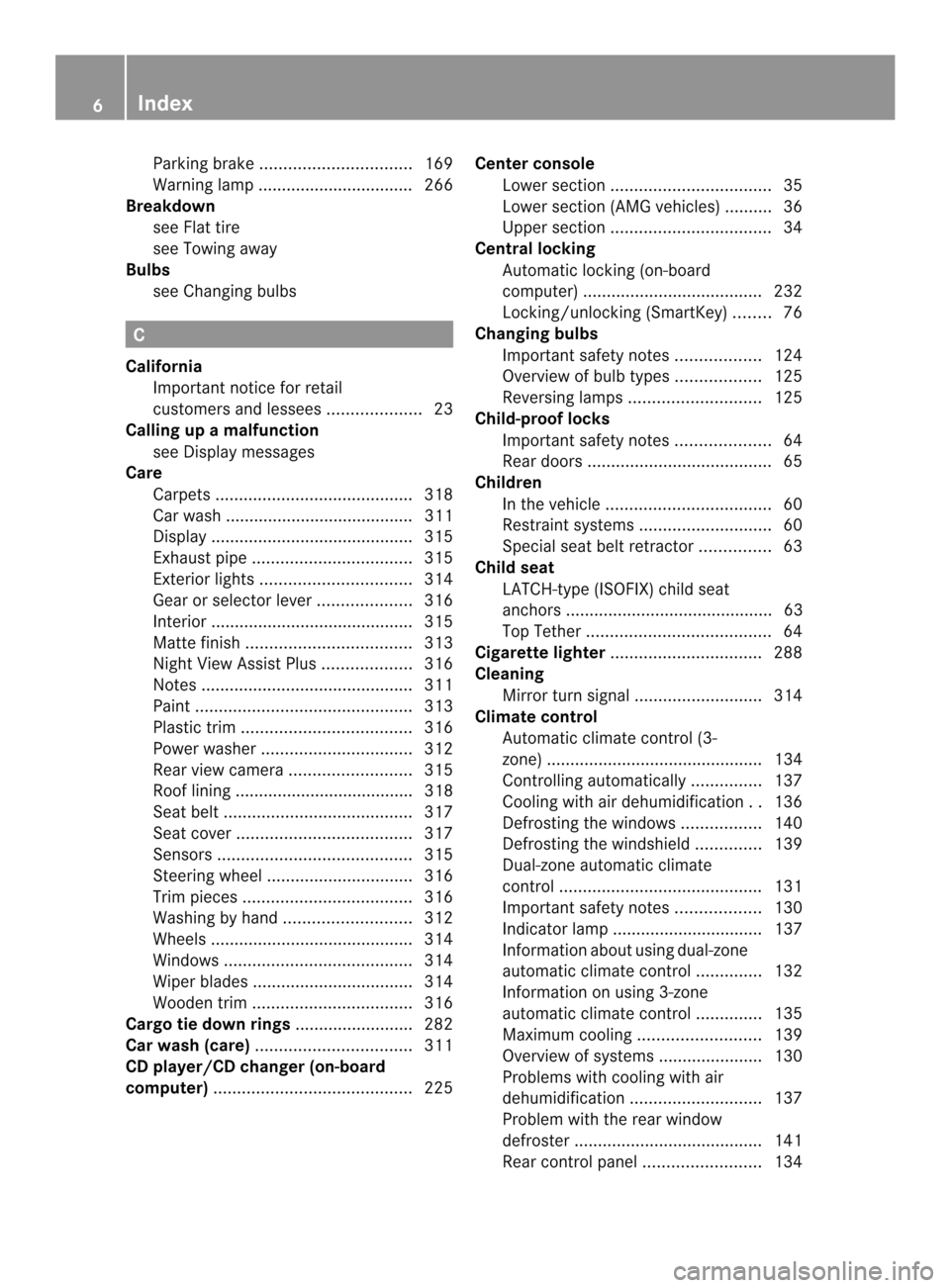
Parking brake
................................ 169
Warning lamp ................................. 266
Breakdown
see Flat tire
see Towing away
Bulbs
see Changing bulbs C
California Important notice for retail
customers and lessees ....................23
Calling up amalfunction
see Display messages
Care
Carpets .......................................... 318
Carw ash. ....................................... 311
Display ........................................... 315
Exhaus tpipe .................................. 315
Exterior lights ................................ 314
Gea rors electo rlever .................... 316
Interior ........................................... 315
Matte finish ................................... 313
Nigh tView Assist Plus ...................316
Notes ............................................. 311
Paint .............................................. 313
Plastic trim .................................... 316
Power washer ................................ 312
Rea rview camera .......................... 315
Roo flining ...................................... 318
Seat bel t........................................ 317
Seat cover ..................................... 317
Sensors ......................................... 315
Steering wheel ............................... 316
Trim pieces .................................... 316
Washing by hand ........................... 312
Wheels ........................................... 314
Windows ........................................ 314
Wiper blades .................................. 314
Wooden trim .................................. 316
Cargo tie dow nrings ......................... 282
Car wash (care) ................................. 311
CD player/CD changer (on-board
computer) .......................................... 225Center console
Lowe rsection .................................. 35
Lowe rsection (AMG vehicles) ..........36
Uppe rsection .................................. 34
Central locking
Automatic locking (on-board
computer) ...................................... 232
Locking/unlocking (SmartKey) ........76
Changing bulbs
Important safety notes ..................124
Overview of bul btypes .................. 125
Reversing lamps ............................ 125
Child-proof locks
Important safety notes ....................64
Rea rdoors ....................................... 65
Children
In the vehicle ................................... 60
Restraint systems ............................ 60
Specia lseat belt retractor ...............63
Child seat
LATCH-typ e(ISOFIX) chil dseat
anchors ............................................ 63
Top Tether ....................................... 64
Cigarette lighter ................................ 288
Cleaning Mirro rturn signal ........................... 314
Climate control
Automatic climate control (3-
zone) .............................................. 134
Controlling automatically ...............137
Cooling with aird ehumidification..136
Defrosting the windows .................140
Defrosting the windshield ..............139
Dual-zone automatic climate
control ........................................... 131
Important safety notes ..................130
Indicator lamp ................................ 137
Information about using dual-zone
automatic climate control ..............132
Information on using 3-zone
automatic climate control ..............135
Maximum cooling .......................... 139
Overview of systems ......................130
Problems with cooling with air
dehumidification ............................ 137
Problem with the rear window
defroster ........................................ 141
Rea rcontrol panel ......................... 1346
Index
Page 14 of 382
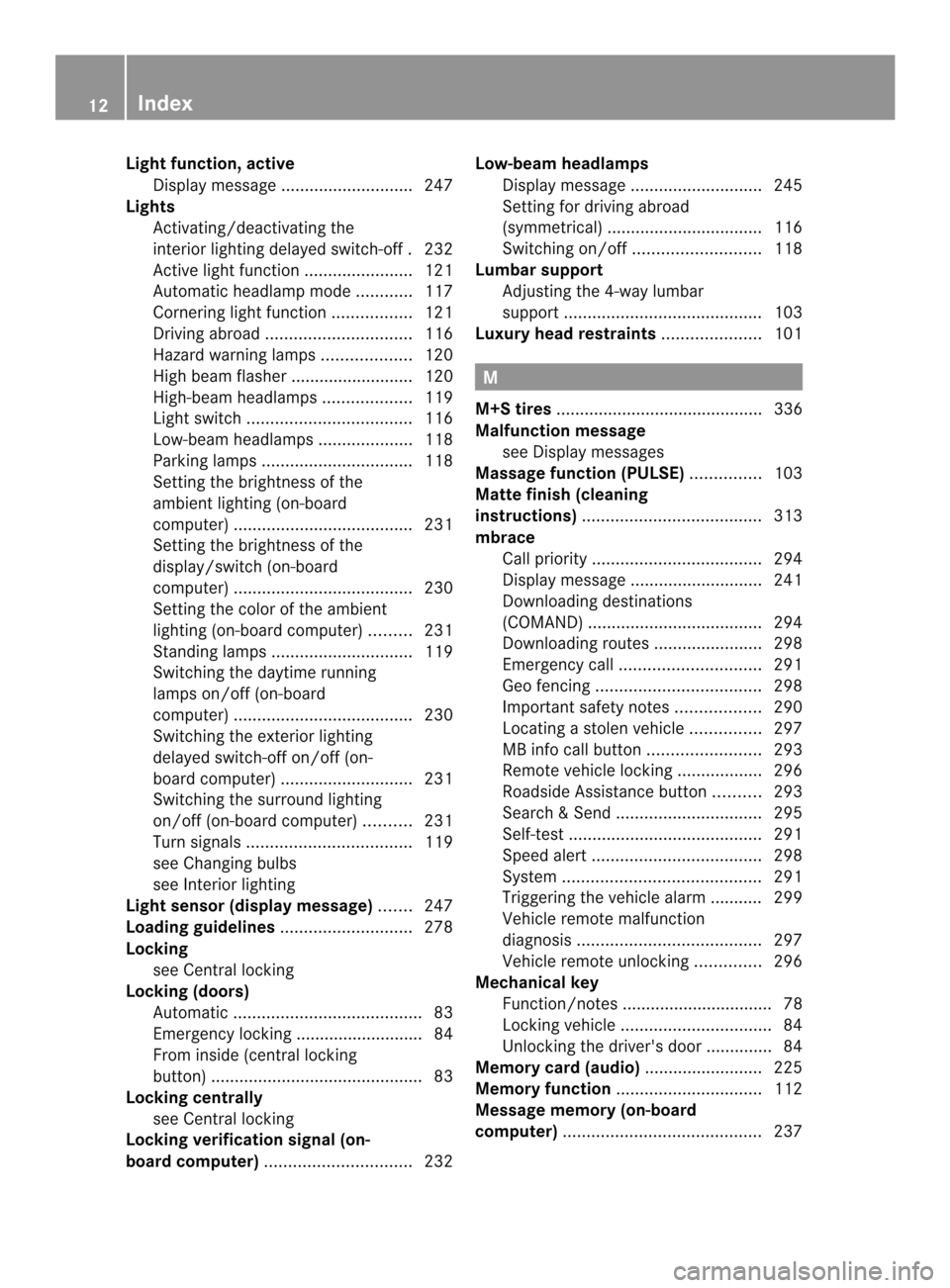
Light function, active
Display message ............................ 247
Lights
Activating/deactivating the
interio rlighting delayed switch-off .232
Active light function .......................121
Automatic headlamp mode ............117
Cornering light function .................121
Driving abroad ............................... 116
Hazard warning lamps ...................120
High bea mflasher .......................... 120
High-beam headlamps ...................119
Ligh tswitc h................................... 116
Low-beam headlamps ....................118
Parking lamps ................................ 118
Setting the brightness of the
ambient lighting (on-board
computer) ...................................... 231
Setting the brightness of the
display/switch (on-board
computer) ...................................... 230
Setting the color of the ambient
lighting (on-board computer) .........231
Standing lamps .............................. 119
Switching the daytime running
lamps on/off (on-board
computer) ...................................... 230
Switching the exterio rlighting
delayed switch-off on/off (on-
board computer )............................ 231
Switching the surround lighting
on/off (on-board computer) ..........231
Turn signals ................................... 119
see Changing bulbs
see Interior lighting
Light sensor (display message) .......247
Loading guidelines ............................278
Locking see Centra llocking
Locking (doors)
Automatic ........................................ 83
Emergency locking ........................... 84
From insid e(central locking
button) ............................................. 83
Locking centrally
see Centra llocking
Locking verification signal (on-
board computer) ............................... 232Low-beam headlamps
Display message ............................ 245
Setting for driving abroad
(symmetrical) ................................. 116
Switching on/off ........................... 118
Lumbar support
Adjusting the 4-way lumbar
support .......................................... 103
Luxury head restraints .....................101 M
M+S tires ............................................ 336
Malfunction message see Display messages
Massag efunction (PULSE) ...............103
Matte finish (cleaning
instructions) ...................................... 313
mbrace Call priority .................................... 294
Display message ............................ 241
Downloading destinations
(COMAND) ..................................... 294
Downloading route s....................... 298
Emergency call .............................. 291
Geo fencing ................................... 298
Important safety notes ..................290
Locating astolen vehicl e............... 297
MB info call button ........................293
Remote vehicle locking ..................296
Roadside Assistance button ..........293
Search &Send ............................... 295
Self-test ......................................... 291
Speed alert .................................... 298
System .......................................... 291
Triggering the vehicle alarm ........... 299
Vehicle remote malfunction
diagnosi s....................................... 297
Vehicle remote unlocking ..............296
Mechanical key
Function/notes ................................ 78
Locking vehicle ................................ 84
Unlocking the driver's door ..............84
Memory card (audio) .........................225
Memory function ............................... 112
Message memory (on-board
computer) .......................................... 23712
Index
Page 16 of 382
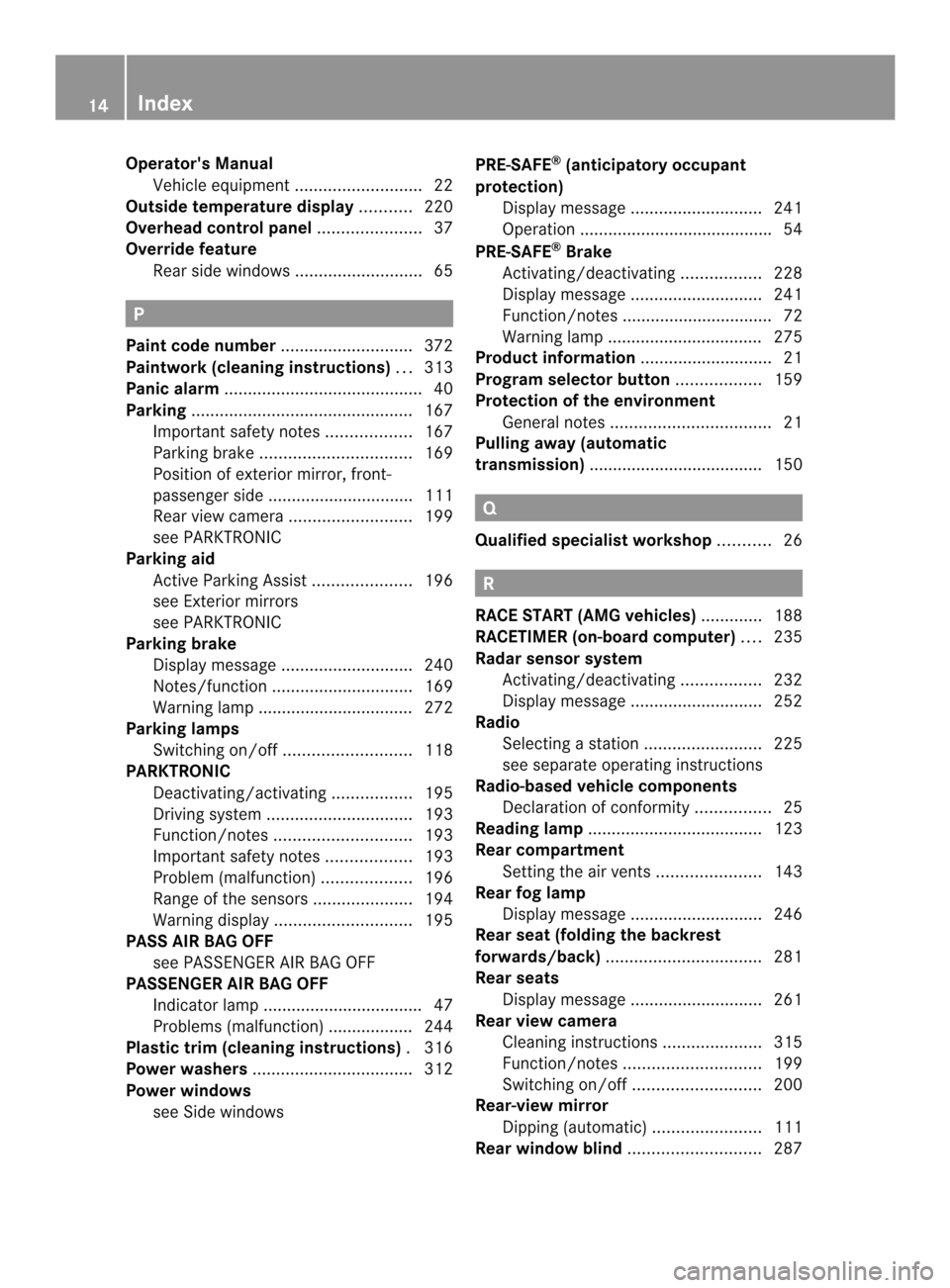
Operator'
sManual
Vehicle equipment ...........................22
Outside temperature display ...........220
Overhead control panel ......................37
Override feature Rea rside windows ........................... 65P
Pain tcode number ............................ 372
Paintwork (cleaning instructions) ...313
Pani calarm .......................................... 40
Parking ............................................... 167
Important safety notes ..................167
Parking brake ................................ 169
Position of exterio rmirror, front-
passenger sid e............................... 111
Rea rview camera .......................... 199
see PARKTRONIC
Parking aid
Active Parking Assist .....................196
see Exterior mirrors
see PARKTRONIC
Parking brake
Display message ............................ 240
Notes/function .............................. 169
Warning lamp ................................. 272
Parking lamps
Switching on/off ........................... 118
PARKTRONIC
Deactivating/activating .................195
Driving system ............................... 193
Function/notes ............................. 193
Important safety notes ..................193
Problem (malfunction) ...................196
Range of the sensors .....................194
Warning displa y............................. 195
PAS SAIRBAG OFF
se eP ASSENG ER AIRBAG OFF
PASSENGER AIR BAG OFF
Indicato rlamp .................................. 47
Problem s(malfunction) .................. 244
Plastic trim (cleaning instructions) .316
Power washers .................................. 312
Power windows see Side windows PRE-SAFE
®
(anticipatory occupant
protection) Display message ............................ 241
Operation ........................................ .54
PRE-SAFE ®
Brake
Activating/deactivating .................228
Display message ............................ 241
Function/notes ................................ 72
Warning lamp ................................. 275
Produc tinformation ............................ 21
Program selector button ..................159
Protection of the environment General notes .................................. 21
Pulling away (automatic
transmission) ..................................... 150 Q
Qualifie dspecialis tworkshop ...........26 R
RAC ESTART (AMG vehicles) .............188
RACETIME R(on-board computer) ....235
Radar sensor system Activating/deactivating .................232
Display message ............................ 252
Radio
Selecting astation ......................... 225
see separate operating instructions
Radio-based vehiclec omponents
Declaratio nofconformity ................ 25
Readin glamp ..................................... 123
Rear compartment Setting the airv ents...................... 143
Rear fog lamp
Display message ............................ 246
Rear seat (foldin gthe backrest
forwards/back) ................................. 281
Rear seats Display message ............................ 261
Rear vie wcamera
Cleaning instructions .....................315
Function/notes ............................. 199
Switching on/off ........................... 200
Rear-vie wmirror
Dipping (automatic) .......................111
Rear window blind ............................28714
Index
Page 17 of 382
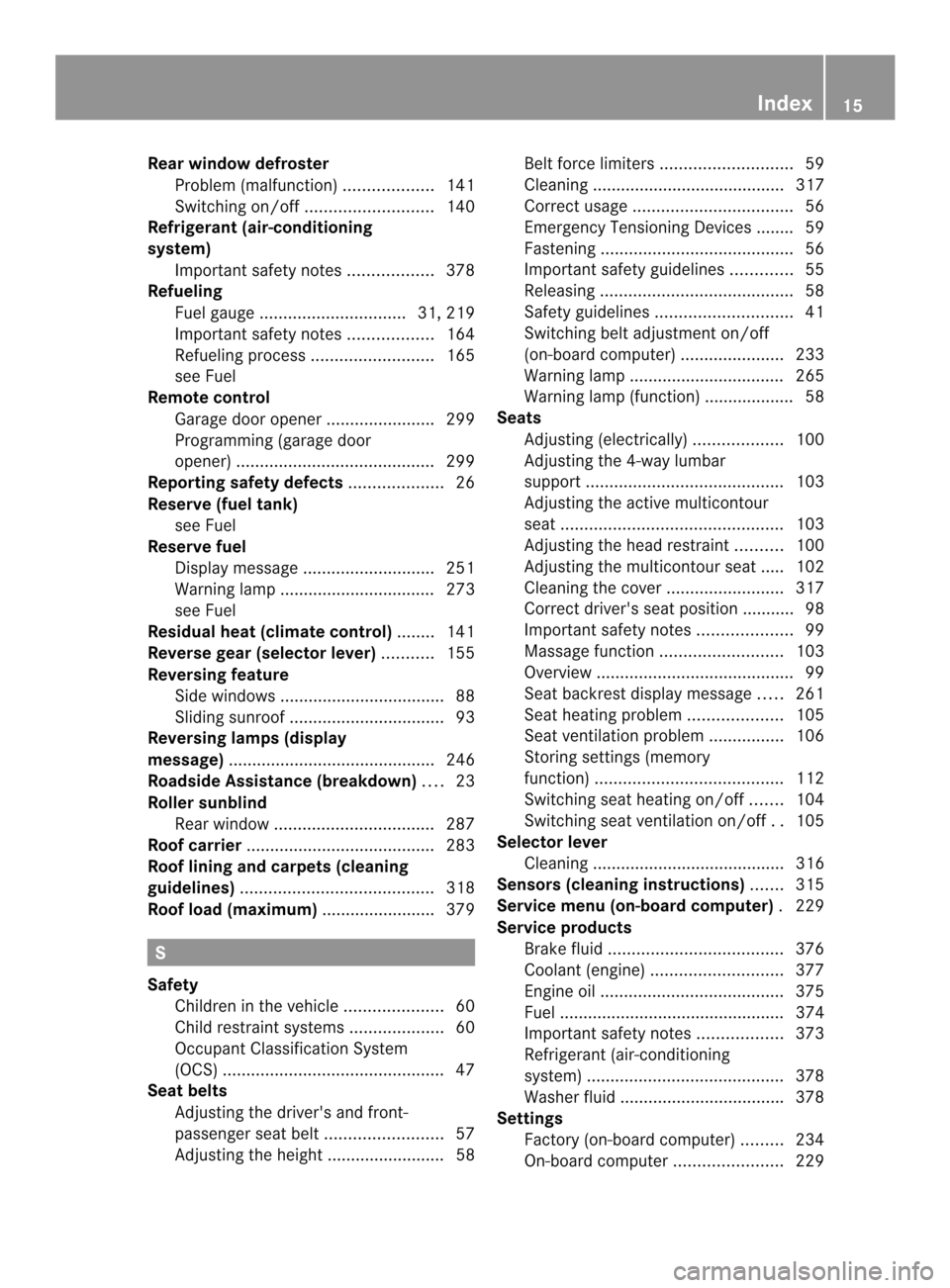
Rear windo
wdefroster
Problem (malfunction) ...................141
Switching on/off ........................... 140
Refrigerant (air-conditioning
system)
Important safety notes ..................378
Refueling
Fuel gauge ............................... 31, 219
Important safety notes ..................164
Refueling proces s.......................... 165
see Fuel
Remote control
Garage door opene r....................... 299
Programming (garage door
opener) .......................................... 299
Reportin gsafety defects ....................26
Reserve (fue ltank)
see Fuel
Reserve fuel
Display message ............................ 251
Warning lamp ................................. 273
see Fuel
Residual heat (climate control) ........141
Reverse gear (selector lever) ...........155
Reversing feature Side windows ................................... 88
Sliding sunroo f................................. 93
Reversing lamps (display
message) ............................................ 246
Roadside Assistanc e(breakdown) ....23
Roller sunblind Rea rwindow .................................. 287
Roof carrier ........................................ 283
Roof lining and carpets (cleaning
guidelines) ......................................... 318
Roof load (maximum) ........................379 S
Safety Childre ninthe vehicle ..................... 60
Child restraint systems ....................60
Occupant Classification System
(OCS) ............................................... 47
Seat belts
Adjusting the driver's and front-
passenger sea tbelt ......................... 57
Adjusting the height ......................... 58 Belt force limiters
............................ 59
Cleaning ......................................... 317
Correct usage .................................. 56
Emergency Tensioning Devices ....... .59
Fastening ......................................... 56
Important safety guidelines .............55
Releasing ......................................... 58
Safety guidelines ............................. 41
Switching bel tadjustment on/off
(on-board computer) ......................233
Warning lamp ................................. 265
Warning lamp (function) ................... 58
Seats
Adjusting (electrically). ..................100
Adjusting the 4-way lumbar
support .......................................... 103
Adjusting the active multicontour
sea t............................................... 103
Adjusting the hea drestraint .......... 100
Adjusting the multicontour sea t..... 102
Cleaning the cover .........................317
Correct driver's sea tposition ........... 98
Important safety notes ....................99
Massag efunction .......................... 103
Overview .......................................... 99
Seat backrest displa ymessage .....261
Seat heating problem ....................105
Seat ventilation problem ................106
Storing settings (memory
function) ........................................ 112
Switching sea theating on/off .......104
Switching sea tventilation on/off ..105
Selector lever
Cleaning ......................................... 316
Sensors (cleaning instructions) .......315
Service menu (on-board computer) .229
Service products Brake fluid ..................................... 376
Coolant (engine) ............................ 377
Engine oil ....................................... 375
Fuel ................................................ 374
Important safety notes ..................373
Refrigerant (air-conditioning
system) .......................................... 378
Washer fluid .................................. .378
Settings
Factory (on-board computer) .........234
On-board computer .......................229 Index
15
Page 24 of 382

Genuine Mercedes-Benz parts
H
Environmental note
Daimle rAGalso supplie sreconditioned major
assemblies and part swhicha re of th esame
qualit yasn ew parts. They are covered by the
same Limite dWarrant yentitlements as new
parts.
! Air bags and Emergenc yTensioning
Devices, as well as control unit sand
sensor sfor these restraint systems ,may be
installe dinthefollowin gareas of your
vehicle:
R doors
R door pillars
R door sills
R seats
R cockpit
R instrumen tcluster
R cente rconsole
Do no tinstall accessorie ssuchasa udio
system sintheseareas. Do not carry out
repairs or welding .You could impair the
operating efficienc yofthe restraint
systems.
Have aftermarket accessories installed at
aq ualified specialist workshop.
You could jeopardize the operating safety of
your vehicle if you use parts, tires and wheels
as well as accessories relevant to safety
which have not been approved by Mercedes.
This could lead to malfunctions in safety-
relevant systems, e.g. the brake system. Use
only genuine Mercedes-Benz parts or parts of
equal quality. Only use tires, wheels and
accessories that have been specifically
approved for your vehicle.
Genuine Mercedes-Benz parts are subject to
strictq ualitycontrol. Every part ha sbeen
specifically developed ,manufactured or
selected for and adapted to Mercedes-Benz
vehicles. Only genuine Mercedes-Benz parts
should therefore be used. More than 300,000 different genuine
Mercedes-Benz parts are available for
Mercedes-Benz models.
All authorized Mercedes-Benz Centers
maintai
nasupply of genuine Mercedes-Benz
parts for necessary service and repair work.
In addition, strategically located parts
delivery centers provide quick and reliable
parts service.
Alwayss pecify the vehicle identification
number (VIN) (Y page 372) and the engine
number (Y page 373) when ordering genuine
Mercedes-Benz parts. Operator's Manual
Vehicle equipment
This Operator's Manual describes all models
and all standard and optional equipment of
your vehicle available at the time of going to
print. Country-specific differences are
possible.B ear in mind that your vehicle may
not feature all function sdescribed here. This
also applies to safety-relevant systems and
functions. The equipment in your vehicle may
therefore differ from that shown in the
descriptions and illustrations.
The original purchase agreement lists all
systems installed in your vehicle.
Should you have any questions concerning
equipment and operation ,please consult an
authorized Mercedes-BenzC enter.
The Operator's Manual and Maintenance
Booklet are important documents and should
be kept in the vehicle. 22
Introduction
Page 43 of 382
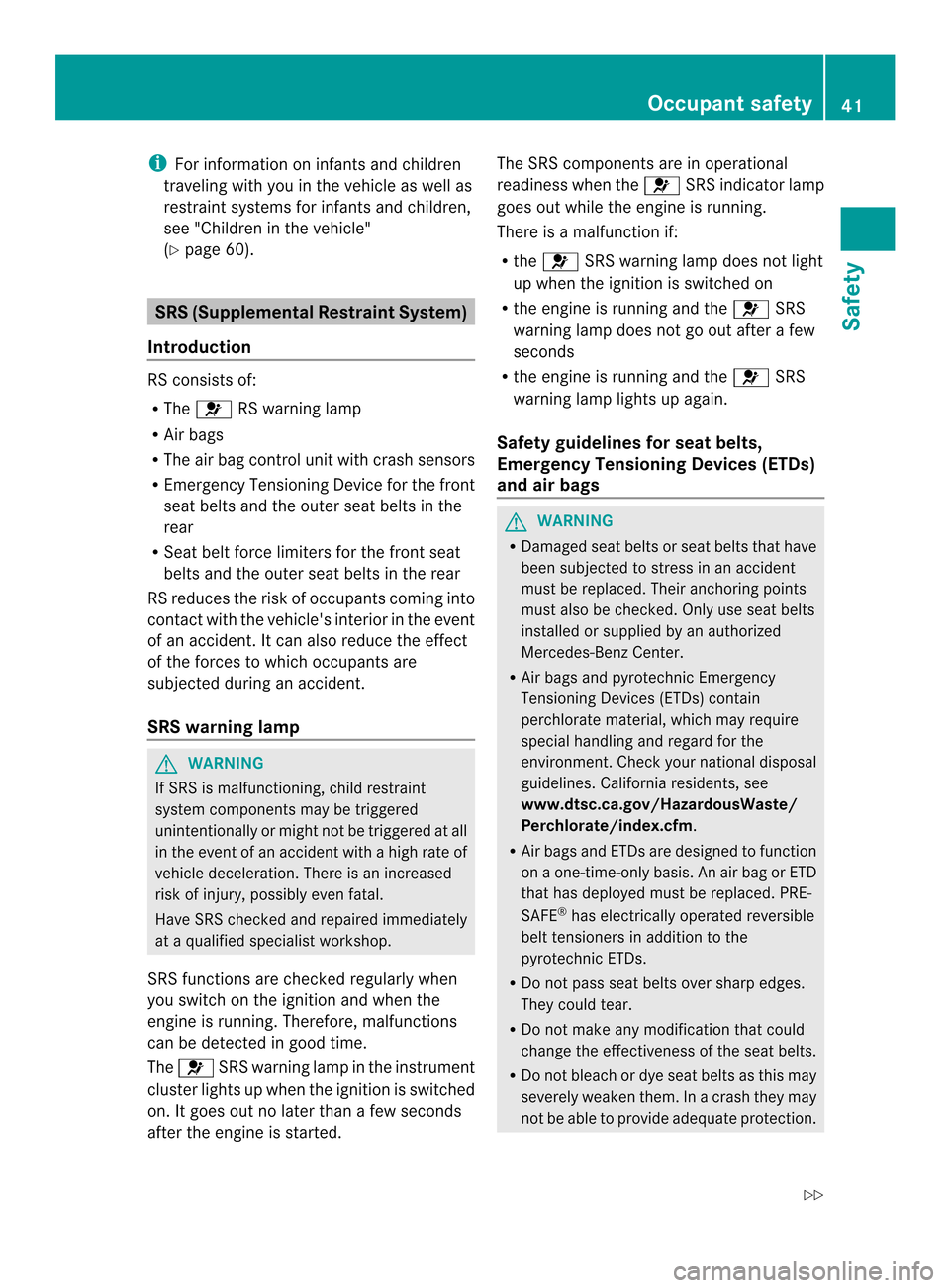
i
For information on infants and children
traveling with yo uinthe vehicle as well as
restraint systems for infants and children,
see "Childre ninthe vehicle"
(Y page 60). SRS (Supplemental Restraint System)
Introduction RS consistso
f:
R The 0012 RS warning lamp
R Air bags
R The air bag control unit with crash sensors
R Emergency Tensioning Device for the front
seat belts and the outer seat belts in the
rear
R Seat belt force limiters for the front seat
belts and the outer seat belts in the rear
RS reduces the risk of occupants coming into
contact with the vehicle's interior in the event
of an accident. It can also reduce the effect
of the forces to which occupants are
subjected during an accident.
SRS warning lamp G
WARNING
If SRS is malfunctioning, child restraint
system components may be triggered
unintentionally or might not be triggered at all
in the event of an accident with ahigh rate of
vehicle deceleration. There is an increased
risk of injury, possibly even fatal.
Have SRS checked and repaired immediately
at aq ualified specialist workshop.
SRS functions are checked regularly when
you switch on the ignition and when the
engine is running. Therefore, malfunctions
can be detected in good time.
The 0012 SRS warning lamp in the instrument
cluster lights up when the ignition is switched
on. It goes out no later than afew seconds
after the engine is started. The SRS components are in operational
readiness when the
0012SRS indicator lamp
goes out while the engine is running.
There is amalfunction if:
R the 0012 SRS warning lamp does not light
up when the ignition is switched on
R the engine is running and the 0012SRS
warning lamp does not go out after afew
seconds
R the engine is running and the 0012SRS
warning lamp lights up again.
Safety guidelines for seat belts,
Emergency Tensioning Devices (ETDs)
and air bags G
WARNING
R Damaged seat belts or seat belts that have
been subjected to stress in an accident
must be replaced. Their anchoring points
must also be checked. Only use seat belts
installed or supplied by an authorized
Mercedes-Ben zCenter.
R Air bags and pyrotechnic Emergency
Tensioning Devices (ETDs) contain
perchlorate material, which may require
special handling and regard for the
environment. Check your national disposal
guidelines. California residents, see
www.dtsc.ca.gov/HazardousWaste/
Perchlorate/index.cfm.
R Air bags and ETDs are designed to function
on aone-time-only basis. An air bag or ETD
that has deployed must be replaced. PRE-
SAFE ®
has electrically operated reversible
belt tensionersina ddition to the
pyrotechnic ETDs.
R Do not pass seat belts over sharp edges.
They could tear.
R Do not make any modification that could
change the effectiveness of the seat belts.
R Do not bleach or dye seat belts as this may
severely weaken them. In acrash they may
not be able to provide adequate protection. Occupant safety
41Safety
Z
Page 47 of 382
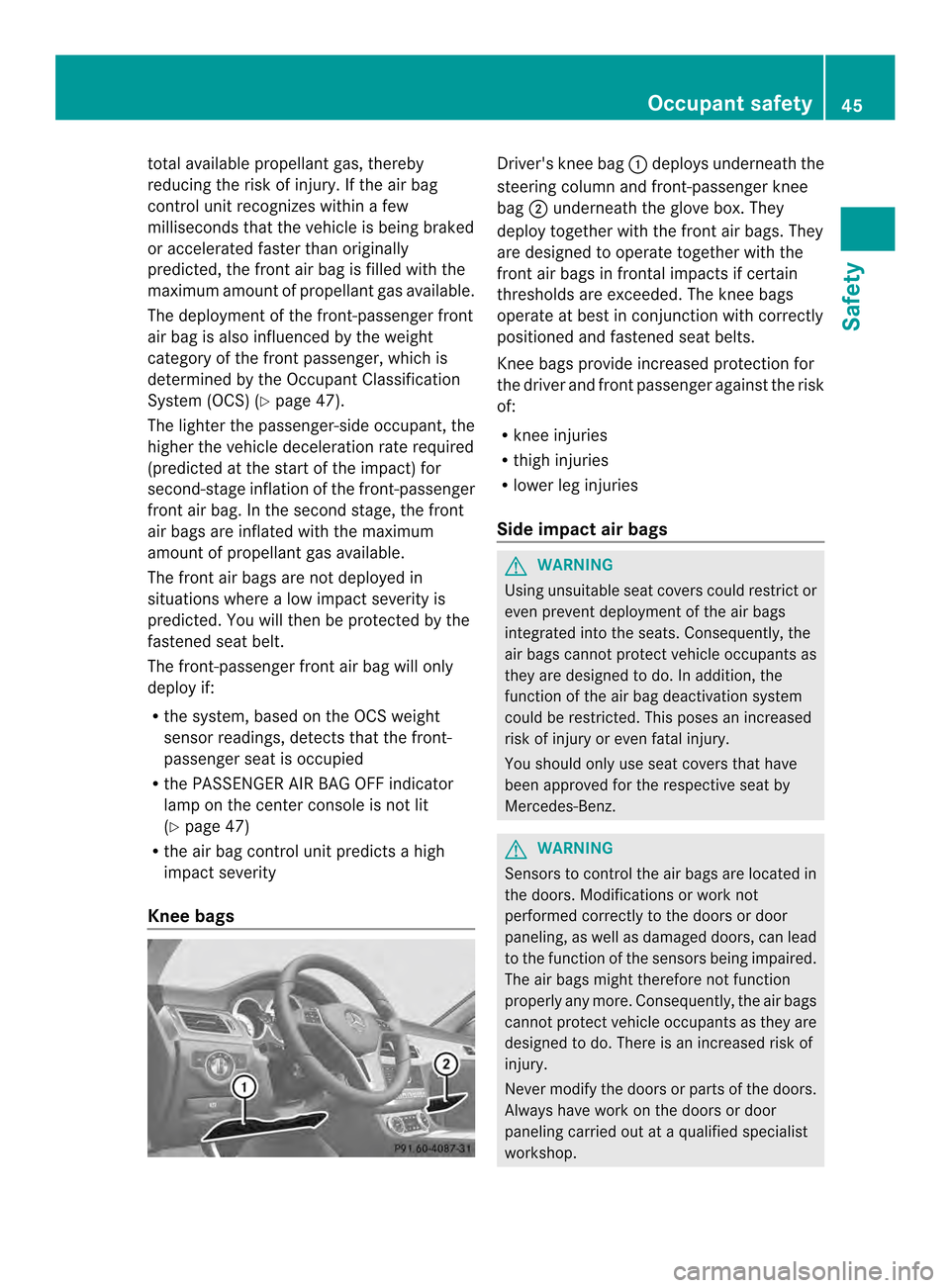
tota
lavailable propellant gas, thereby
reducing the risk of injury .Ifthe ai rbag
control uni trecognize swithi naf ew
milliseconds tha tthe vehicle is being braked
or accelerated faster than originally
predicted, the front air bag is filled with the
maximum amount of propellant gas available.
The deployment of the front-passenger front
air bag is also influenced by the weight
category of the front passenger, which is
determined by the Occupant Classification
System (OCS) (Y page 47).
The lighter the passenger-side occupant, the
higher the vehicle deceleration rate required
(predicted at the start of the impact) for
second-stage inflation of the front-passenger
front air bag. In the second stage, the front
air bags are inflated with the maximum
amount of propellant gas available.
The front air bags are not deployed in
situations where alow impact severity is
predicted. You will then be protected by the
fastened seat belt.
The front-passenger front air bag will only
deploy if:
R the system, based on the OCS weight
sensor readings, detectst hat the front-
passenger seat is occupied
R the PASSENGER AIR BAG OFF indicator
lamp on the center console is not lit
(Y page 47)
R the air bag control unit predicts ahigh
impact severity
Knee bags Driver's knee bag
001Adeploysu nderneath the
steering column and front-passenger knee
bag 0010underneath the glove box. They
deploy together with the front air bags. They
are designed to operate together with the
front air bags in frontal impacts if certain
thresholds are exceeded. The knee bags
operate at best in conjunction with correctly
positioned and fastened seat belts.
Knee bags provide increased protection for
the driver and front passenger against the risk
of:
R knee injuries
R thigh injuries
R lower leg injuries
Side impact air bags G
WARNING
Using unsuitable seat covers could restrict or
even prevent deployment of the air bags
integrated into the seats. Consequently, the
air bags cannot protect vehicle occupants as
they are designed to do. In addition, the
function of the air bag deactivation system
could be restricted. This poses an increased
risk of injury or even fatal injury.
You should only use seat covers that have
been approved for the respective seat by
Mercedes-Benz. G
WARNING
Sensors to control the air bags are located in
the doors. Modifications or work not
performed correctly to the doors or door
paneling, as well as damaged doors, can lead
to the function of the sensors being impaired.
The air bags might therefore not function
properly any more. Consequently, the air bags
cannot protect vehicle occupants as they are
designed to do. There is an increased risk of
injury.
Never modify the doors or parts of the doors.
Always have work on the doors or door
paneling carried out at aqualified specialist
workshop. Occupant safety
45Safety Z
Page 50 of 382
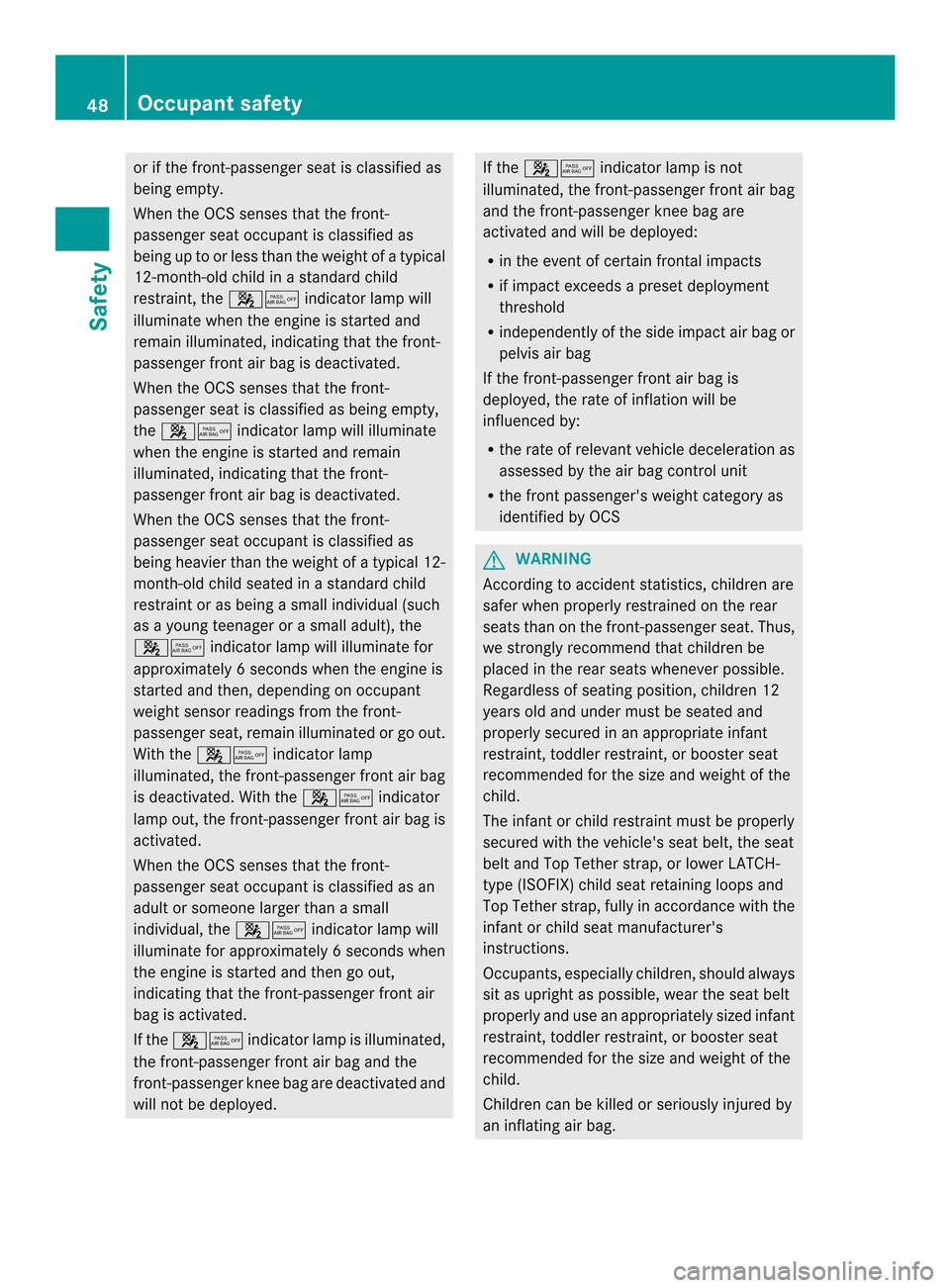
or if the front-passenger seat is classified as
being empty.
When the OCS senses that the front-
passenger seat occupant is classified as
being up to or less than the weight of atypical
12-month-old child in astandard child
restraint ,the 000F000B indicator lamp will
illuminate when the engine is started and
remain illuminated, indicating that the front-
passenger front air bag is deactivated.
When the OCS senses that the front-
passenger seat is classified as being empty,
the 000F000B indicator lamp will illuminate
when the engine is started and remain
illuminated, indicating that the front-
passenger front air bag is deactivated.
When the OCS senses that the front-
passenger seat occupant is classified as
being heavier than the weight of atypical 12-
month-old child seated in astandar dchild
restraint or as being asmall individual (such
as ayoung teenager or asmall adult), the
000F000B indicator lamp willi lluminate for
approximatel y6seconds when the engine is
started and then ,depending on occupant
weight sensor readings from the front-
passenger seat, remain illuminated or go out.
With the 000F000B indicator lamp
illuminated, the front-passenger fron tair bag
is deactivated. With the 000F000Bindicator
lamp out, the front-passenge rfront air bag is
activated.
When the OCS senses that the front-
passenger seat occupant is classifie dasan
adult or someone larger than asmall
individual, the 000F000Bindicator lamp will
illuminate for approximatel y6seconds when
the engine is started and then go out,
indicating that the front-passenger fron tair
bag is activated.
If the 000F000B indicator lamp is illuminated,
the front-passenger fron tair bag and the
front-passenger knee bag are deactivated and
will not be deployed. If the
000F000B indicator lamp is not
illuminated, the front-passenger fron tair bag
and the front-passenge rknee ba gare
activate dand will be deployed:
R in the event of certain fronta limpacts
R if impact exceed sapreset deployment
threshold
R independentl yofthe side impact ai rbag or
pelvis air bag
If th efront-pa ssenger fron tair bag is
deployed, th erateofi nflation will be
influenced by:
R ther ateofr elevan tvehicle deceleration as
assessed by the air bag control unit
R the fron tpassenger's weigh tcategor yas
identified by OCS G
WARNING
Accordin gtoacciden tstatistics, childre nare
safe rwhen properly restrained on the rear
seats than on the front-passenger seat. Thus,
we strongly recommendt hat children be
placed in the rear seats whenever possible.
Regardless of seating position, children 12
years old and under must be seated and
properly secured in an appropriate infant
restraint,t oddler restraint,orb ooster seat
recommended for the size and weight of the
child.
The infant or child restraint must be properly
secured with the vehicle's seat belt, the seat
belt and Top Tether strap, or lower LATCH-
type (ISOFIX) child seat retaining loops and
Top Tether strap, fully in accordance with the
infant or child seat manufacturer's
instructions.
Occupants, especially children, should always
sit as upright as possible, wear the seat belt
properly and use an appropriately sized infant
restraint,t oddler restraint,orb ooster seat
recommended for the size and weight of the
child.
Children can be killed or seriously injured by
an inflating air bag. 48
Occupant safetySafety
Page 52 of 382
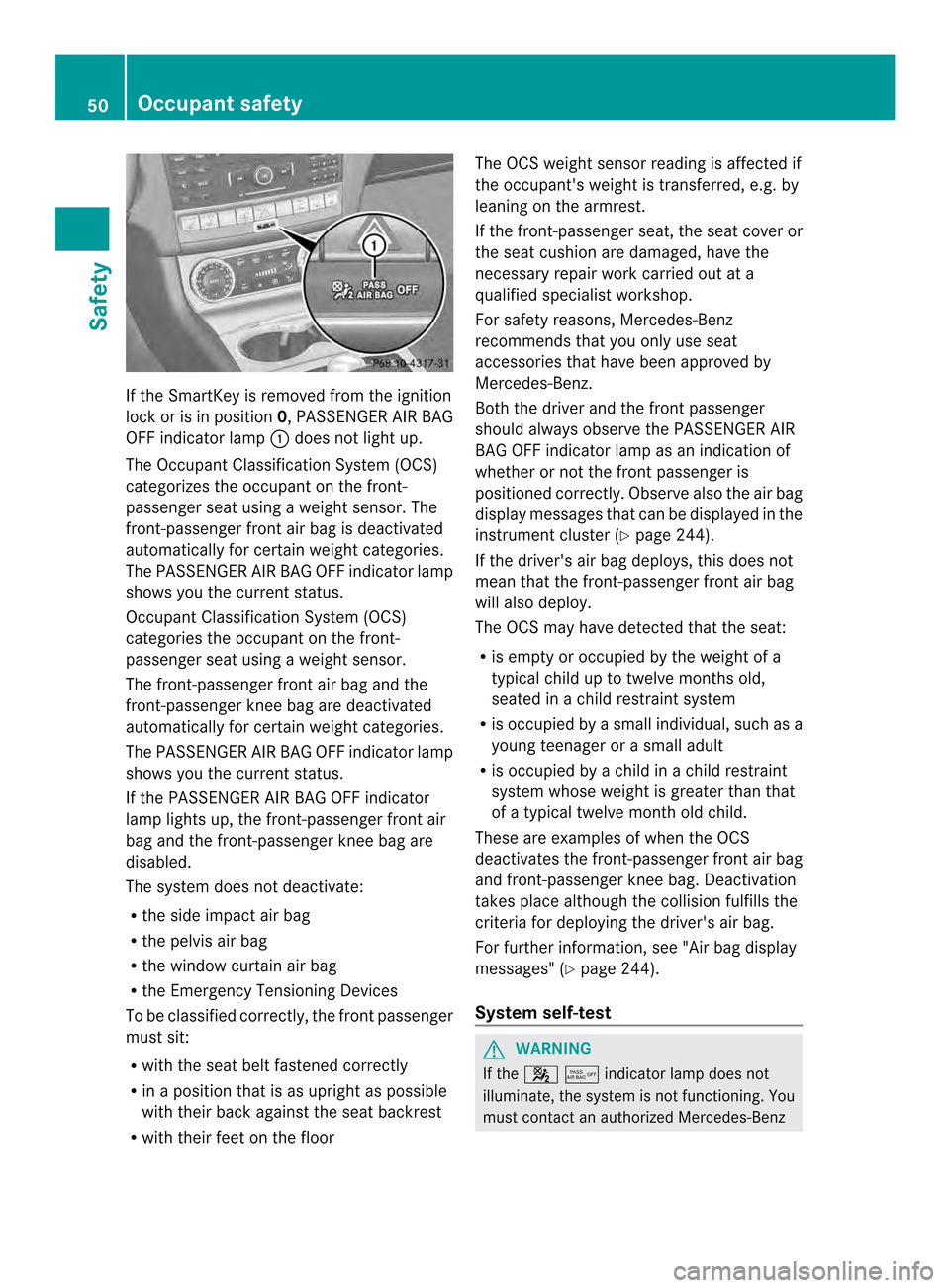
If the SmartKey is removed from the ignition
lock or is in position 0,PASSENGER AIR BAG
OFF indicator lamp 001Adoes not light up.
The Occupant Classification System (OCS)
categorize sthe occupant on the front-
passenge rseat using aweight sensor .The
front-passenger front air bag is deactivated
automatically for certain weight categories.
The PASSENGER AIR BAG OFF indicator lamp
shows you the current status.
Occupant Classification System (OCS)
categories the occupant on the front-
passenger seat using aweight sensor.
The front-passenger front air bag and the
front-passenger knee bag are deactivated
automatically for certain weight categories.
The PASSENGER AIR BAG OFF indicator lamp
shows you the current status.
If the PASSENGER AIR BAG OFF indicator
lamp lights up, the front-passenger front air
bag and the front-passenger knee bag are
disabled.
The system does not deactivate:
R the side impact air bag
R the pelvis air bag
R the window curtain air bag
R the Emergency Tensioning Devices
To be classified correctly, the front passenger
must sit:
R with the seat belt fastened correctly
R in ap osition that is as upright as possible
with their back against the seat backrest
R with their feet on the floor The OCS weight sensor reading is affected if
the occupant's weight is transferred, e.g. by
leaning on the armrest.
If the front-passenger seat, the seat cover or
the seat cushion are damaged, have the
necessary repair work carried out at a
qualified specialist workshop.
For safety reasons, Mercedes-Benz
recommends that you only use seat
accessories that have been approved by
Mercedes-Benz.
Both the driver and the front passenger
should always observe the PASSENGER AIR
BAG OFF indicator lamp as an indication of
whether or not the front passenger is
positioned correctly. Observe also the air bag
displaym essages that can be displayed in the
instrumentc luster (Ypage 244).
If the driver's air bag deploys, this does not
mean that the front-passenger front air bag
will also deploy.
The OCS may have detected that the seat:
R is empty or occupied by the weight of a
typical child up to twelve months old,
seated in achild restraint system
R is occupied by asmall individual, such as a
young teenager or asmall adult
R is occupied by achild in achild restraint
system whose weight is greater than that
of at ypical twelve montho ld child.
These are examples of when the OCS
deactivates the front-passenger front air bag
and front-passenger knee bag. Deactivation
takes place although the collision fulfills the
criteria for deploying the driver's air bag.
For further information ,see "Air bag display
messages" (Y page 244).
System self-test G
WARNING
If the 000F000Bindicator lamp does not
illuminate, the system is not functioning. You
must contac tanauthorized Mercedes-Benz 50
Occupant safetySafety
Page 57 of 382
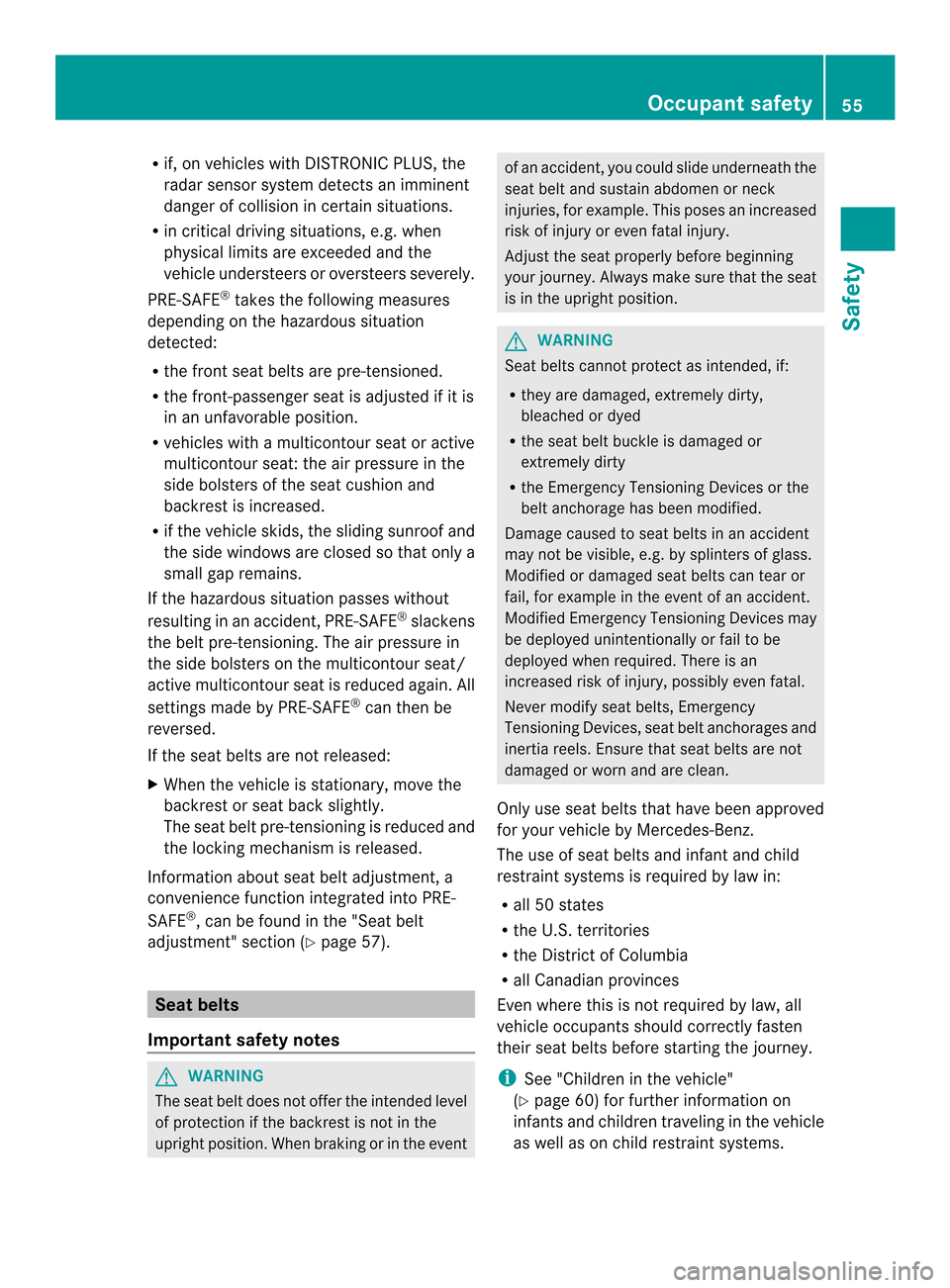
R
if, on vehicles with DISTRONIC PLUS ,the
radar sensor system detect sanimminent
dange rofcollision in certain situations.
R in critical driving situations, e.g. when
physical limits are exceeded and the
vehicle understeers or oversteers severely.
PRE-SAFE ®
takes the following measures
depending on the hazardous situation
detected:
R the front seat belts are pre-tensioned.
R the front-passenger seat is adjusted if it is
in an unfavorable position.
R vehicles with amulticontour seat or active
multicontour seat: the air pressure in the
side bolsters of the seat cushion and
backrest is increased.
R if the vehicle skids, the sliding sunroof and
the side windows are closed so that only a
small gap remains.
If the hazardous situation passes without
resulting in an accident ,PRE-SAFE ®
slackens
the belt pre-tensioning. The air pressure in
the side bolsters on the multicontour seat/
active multicontour seat is reduced again. All
settings made by PRE-SAFE ®
can then be
reversed.
If the seat belts are not released:
X When the vehicle is stationary, move the
backrest or seat back slightly.
The seat belt pre-tensionin gisreduced and
the lockin gmechanism is released.
Information about seat belt adjustment, a
convenienc efunction integrated into PRE-
SAFE ®
,c an be found in the "Seat belt
adjustment" section (Y page 57).Seat belts
Important safety notes G
WARNING
The seat belt does not offer the intended level
of protection if the backrest is not in the
upright position. When braking or in the event of an accident
,you could slide underneath the
seat belt and sustain abdomen or neck
injuries, for example. This poses an increased
risk of injury or even fatal injury.
Adjust the seat properly before beginning
your journey. Always make sure that the seat
is in the upright position. G
WARNING
Seat belts cannot protect as intended, if:
R they are damaged, extremely dirty,
bleached or dyed
R the seat belt buckle is damaged or
extremely dirty
R the Emergency Tensionin gDevices or the
belt anchorage has been modified.
Damage caused to seat belts in an accident
may not be visible, e.g. by splinters of glass.
Modified or damaged seat belts can tear or
fail, for example in the event of an accident.
Modified Emergency Tensionin gDevices may
be deployed unintentionally or fail to be
deployed when required. There is an
increased risk of injury, possibly even fatal.
Never modify seat belts, Emergency
Tensionin gDevices, seat belt anchorages and
inertia reels. Ensure that seat belts are not
damaged or worn and are clean.
Only use seat belts that have been approved
for your vehicle by Mercedes-Benz.
The use of seat belts and infant and child
restraint systems is required by law in:
R all 50 states
R the U.S. territories
R the District of Columbia
R all Canadia nprovinces
Even where this is not required by law,a ll
vehicl eoccupants should correctly fasten
their seat belts before starting the journey.
i See "Children in the vehicle"
(Y page6 0) for further information on
infants and children traveling in the vehicle
as wellasonc hild restraint systems. Occupant safety
55Safety Z